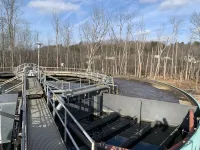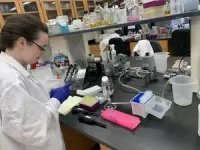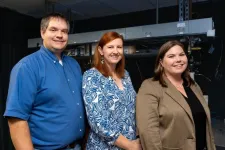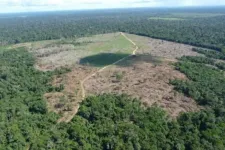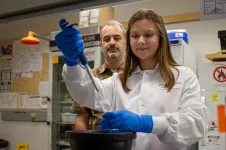(Press-News.org) UNIVERSITY PARK, Pa. — First used in the 1940s to monitor for polio, wastewater surveillance proved such a powerful disease monitoring tool that the U.S. Centers for Disease Control and Prevention (CDC) established the National Wastewater Surveillance System to support SARS-CoV-2 monitoring in September of 2020. Now, a team of scientists from Penn State and the Pennsylvania Department of Health have shown that domestic sewage monitoring is useful for a foodborne pathogen as well.
In findings published today (Sept. 19) in the Journal of Clinical Microbiology, the researchers report that the bacteria Salmonella enterica was detected in samples from two wastewater treatment plants in central Pennsylvania during June 2022.
“Non-typhoidal Salmonella is a common cause of gastroenteritis worldwide, but current surveillance for the disease is suboptimal, so in this research we evaluated the utility of wastewater monitoring to enhance surveillance for this foodborne pathogen,” said Nkuchia M’ikanatha, lead epidemiologist, Pennsylvania Department of Health and an affiliated researcher in Penn State’s Department of Food Science, in the College of Agricultural Sciences. "In this study, we explored wastewater monitoring as a tool to enhance surveillance for this foodborne pathogen. Wastewater testing can detect traces of infectious diseases circulating in a community, even in asymptomatic individuals, offering an early warning system for potential outbreaks."
While health care providers are required to report salmonellosis cases, many go undetected. Salmonella bacteria, inhabiting the intestines of animals and humans, are shed in feces. The CDC estimates Salmonella causes roughly 1.35 million infections, 26,500 hospitalizations and 420 deaths annually in the U.S., primarily through contaminated food.
In June 2022, the researchers tested raw sewage samples collected twice a week from two treatment plants in central Pennsylvania for non-typhoidal Salmonella and characterized isolates using whole genome sequencing. They recovered 43 Salmonella isolates from wastewater samples, differentiated by genomic analysis into seven serovars, which are groupings of microorganisms based on similarities. Eight of the isolates, or nearly 20%, were from a rare type of Salmonella called Baildon.
The researchers assessed genetic relatedness and epidemiologic links between non-typhoidal Salmonella isolates from wastewater and similar bacteria from patients with salmonellosis. The Salmonella Baildon serovars isolated from wastewater were genetically indistinguishable from a similar bacteria found in a patient associated with a salmonellosis outbreak in the same period in the area. Salmonella Baildon from wastewater and 42 outbreak-related isolates in the national outbreak detection database had the same genetic makeup. One of the 42 outbreak-related isolates was obtained from a patient residing in the wastewater study sample collection catchment area, which serves approximately 17,000 people.
Salmonella Baildon is a rare serovar — reported in less than 1% of cases nationally over five years, noted M’ikanatha, the study’s first author. He pointed out that this research demonstrates the value of monitoring sewage from a defined population to supplement traditional surveillance methods for evidence of Salmonella infections and to determine the extent of outbreaks.
“Using whole genome sequencing, we showed that isolates of variant Salmonella Baildon clustered with those from an outbreak that occurred in a similar time frame,” he said. “Case reports were primarily from Pennsylvania, and one individual lived within the treatment plant catchment area. This study provides support for using domestic sewage surveillance in assisting public health agencies to identify communities impacted by infectious diseases.”
Ed Dudley, a professor of food science and the senior author on the study, said these findings highlight the potential of wastewater monitoring as an early warning system for foodborne disease outbreaks, potentially even before physicians and laboratories report cases. This proactive approach could enable health officials to swiftly trace the source of contaminated food, ultimately reducing the number of people affected, suggested Dudley, who also directs Penn State’s E. coli Reference Center.
“While it may not happen overnight, I foresee a future where many, if not most, domestic wastewater treatment plants contribute untreated sewage samples for monitoring evidence of various illnesses,” he said. “This would likely involve collaboration among public health agencies, academia and federal entities, much like our pilot study. I see this as yet another crucial lesson from the pandemic.”
Contributing to the research at Penn State were Jasna Kovac, associate professor of food science and Lester Earl and Veronica Casida Career Development Professor of Food Safety; Erin Nawrocki and Yezhi Fu, postdoctoral scholars in the Dudley Lab; Zoe Goldblum, undergraduate researcher in the Department of Food Science; and Nicholas Cesari, Division of Infectious Disease Epidemiology, Pennsylvania Department of Health.
The CDC, the U.S. Food and Drug Administration and the U.S. Department of Agriculture’s National Institute of Food and Agriculture provided funding for this research.
END
Wastewater monitoring can detect foodborne illness, researchers find
Results of a new study suggest sewage monitoring could provide early warning of foodborne disease outbreaks to public health authorities
2024-09-20
ELSE PRESS RELEASES FROM THIS DATE:
Kowalski, Salonvaara receive ASHRAE Distinguished Service Awards
2024-09-20
Building equipment and envelope scientists at the Department of Energy’s Oak Ridge National Laboratory were recognized for research excellence during the ASHRAE 2024 summer conference held in Indianapolis.
Stephen Kowalski and Mikael Salonvaara received the Distinguished Service Award, which salutes members who have served the society with distinction in chapter, regional and society activities. Kowalski and Salonvaara have each been active members of ASHRAE for more than 25 years and have supported the organization’s Technical and Standards Project Committees.
ASHRAE is the largest international professional organization ...
SkAI launched to further explore universe
2024-09-20
Funded by a five-year, $20 million grant from the U.S. National Science Foundation (NSF) and the Simons Foundation, the National Center for Supercomputing Applications is partnering with other academic institutions and federal laboratories in the Midwest to develop new artificial intelligence (AI) tools to advance astrophysics research and exploration of the universe.
Led by Northwestern University, the collaboration will establish the NSF-Simons AI Institute for the Sky or SkAI (pronounced “sky”), one of two AI research centers that will help astronomers better understand the cosmos.
Located close to NCSA’s home in Illinois, SkAI will ...
SLU researchers identify sex-based differences in immune responses against tumors
2024-09-20
ST. LOUIS — Researchers at Saint Louis University School of Medicine investigated differences in T-cell responses between male and female patients with lung cancer that may help direct future treatments. T-cell responses are part of the adaptive immune system, part of the body’s “smart system” that monitors for threats and fights them with customized defenses.
"Therapies that use the patient's immune system to fight their disease have a lot of potential to ...
Evolved in the lab, found in nature: uncovering hidden pH sensing abilities
2024-09-20
By Andy Flick, Evolutionary Studies scientific coordinator
In a groundbreaking study led by Sarah Worthan, Ph.D., a postdoctoral researcher in the Behringer Lab at Vanderbilt University, scientists have successfully evolved microbial cultures that possess the ability to sense pH changes, enabling rapid responses to environmental fluctuations. Along with highlighting the power of lab-driven evolution, this discovery also led to finding similar mutations in nature in emerging pathogens and coral symbionts—organisms that navigate challenging pH shifts in their environments and are ...
Unlocking the potential of patient-derived organoids for personalized sarcoma treatment
2024-09-20
Investigators at the UCLA Health Jonsson Comprehensive Cancer Center have developed the largest collection of sarcoma patient-derived organoids to date that can help improve the understanding of the disease and better identify therapies that are most likely to work for each individual patient.
The approach, detailed in the journal Cell Stem Cell, uses patients’ own tumor cells that replicate the unique characteristics of a patient's tumor allowing scientists to quickly screen a large number of drugs in order to identify personalized treatments that can target this rare and diverse group of cancers.
“Sarcoma is a rare and complex disease, which makes conducting clinical trials ...
New drug molecule could lead to new treatments for Parkinson’s disease in younger patients
2024-09-20
A novel drug molecule could potentially lead to new treatments to prevent Parkinson’s disease in younger patients, according to new research.
“We are excited about this drug compound because we might have the possibility to develop the first cure for Parkinson’s disease, at least for a subset of patients,” said lead author Kalle Gehring, a Professor in the Department of Biochemistry at McGill University and Canada Research Chair in Structural Studies of Neurodegenerative Diseases.
While Parkinson’s symptoms — slowed movements, tremors and balance problems — often appear in ...
Deforestation in the Amazon is driven more by domestic demand than by the export market
2024-09-20
Brazilian Legal Amazonia (BLA) – which comprises the entirety of the Amazon Basin located in Brazil and vast adjacent swathes of the Cerrado, spanning nine states – is more than 5 million square kilometers (km2) in area and corresponds to almost 60% of the country’s land mass. Almost a quarter of this area (23%) has been deforested, and over 1 million km2 are degraded, so that the region risks reaching an ecological tipping point at which ecosystems collapse and billions of tons of carbon are released into the atmosphere. Some parts of ...
Demand-side actions could help construction sector deliver on net-zero targets
2024-09-20
Using state-of-the-art energy efficiency technologies to renovate existing properties and construct new ones could enable Europe’s construction sector to almost eliminate its carbon emissions by 2060, a new study suggests.
Published in the journal Renewable and Sustainable Energy Reviews, the research is the first to fully assess the potential for energy demand reduction across the construction sectors of the United Kingdom and all European Union member states.
It highlights that 75% of Europe’s building stock is currently classed as energy inefficient, with total floor space also ...
Research team discovers molecular mechanism for a bacterial infection
2024-09-20
Virginia Tech researchers have learned how bacteria manipulate molecules to infect the host organism.
Daniel Capelluto and his research team have discovered the mechanism by which the bacterial pathogen Shigella flexneri, the causative agent of dysentery, manipulates molecular activity to assure its survival against its host’s natural defenses. Their findings were recently published in Structure, a Cell Press journal that supports open access.
“This infection strategy may be employed by other bacteria, making this research a potential foundation for understanding the molecular mechanisms underlying various bacterial infections,” said Capelluto, associate professor ...
What role does a tailwind play in cycling’s ‘Everesting’?
2024-09-20
WASHINGTON, Sept. 20, 2024 – Within the cycling realm, “to Everest” involves riding up and down the same mountain until your ascents total the elevation of Mt. Everest — 8,848 meters.
After a new cycling “Everesting” record was set a few years ago, a debate ensued on social media about the strong tailwind the cyclist had on climbs — 5.5 meters per second (20 kilometers per hour or 12 miles per hour) — when he set the record. To what extent did the tailwind help him? Should limits be set on the allowed ...
LAST 30 PRESS RELEASES:
Revealing the cell’s nanocourier at work
Health impacts of nursing home staffing
Public views about opioid overdose and people with opioid use disorder
Age-related changes in sperm DNA may play a role in autism risk
Ambitious model fails to explain near-death experiences, experts say
Multifaceted effects of inward foreign direct investment on new venture creation
Exploring mutations that spontaneously switch on a key brain cell receptor
Two-step genome editing enables the creation of full-length humanized mouse models
Pusan National University researchers develop light-activated tissue adhesive patch for rapid, watertight neurosurgical sealing
Study finds so-called super agers tend to have at least two key genetic advantages
Brain stimulation device cleared for ADHD in the US is overall safe but ineffective
Scientists discover natural ‘brake’ that could stop harmful inflammation
Tougher solid electrolyte advances long-sought lithium metal batteries
Experts provide policy roadmap to reduce dementia risk
New 3D imaging system could address limitations of MRI, CT and ultrasound
First-in-human drug trial lowers high blood fats
Decades of dredging are pushing the Dutch Western Scheldt Estuary beyond its ecological limits
A view into the innermost workings of life: First scanning electron microscope with nanomanipulator inaugurated in hesse at Goethe University
Simple method can enable early detection and prevention of chronic kidney disease
S-species-stimulated deep reconstruction of ultra-homogeneous CuS nanosheets for efficient HMF electrooxidation
Mechanical and corrosion behavior of additively manufactured NiTi shape memory alloys
New discovery rewrites the rules of antigen presentation
Researchers achieve chain-length control of fatty acid biosynthesis in yeast
Water interactions in molecular sieve catalysis: Framework evolution and reaction modulation
Shark biology breakthrough: Study tracks tiger sharks to Maui mating hub
Mysterious iron ‘bar’ discovered in famous nebula
World-first tool reduces harmful engagement with AI-generated explicit images
Learning about public consensus on climate change does little to boost people’s support for action, study shows
Sylvester Cancer Tip Sheet for January 2026
The Global Ocean Ship-Based Hydrographic Investigations Program (GO-SHIP) receives the Ocean Observing Team Award
[Press-News.org] Wastewater monitoring can detect foodborne illness, researchers findResults of a new study suggest sewage monitoring could provide early warning of foodborne disease outbreaks to public health authorities
